Comprehensive Analysis of Company Valuation and Mergers Report
VerifiedAdded on 2022/12/12
|11
|2268
|106
Report
AI Summary
This report provides a comprehensive overview of company valuation methods, detailing four primary approaches: discounted cash flow (DCF), asset-based valuation, earnings-based valuation, and dividend-based valuation. Each method is thoroughly defined, and its respective advantages and disadvantages are discussed, using the company 'Smallco' as a case study. The report calculates Smallco's valuation using each method. Furthermore, the report explores the economic justifications behind mergers and acquisitions, analyzing the potential impacts on stakeholders and the strategic benefits of such corporate actions, including value creation, market expansion, asset acquisition, and financial strength. References to academic sources support the analysis.
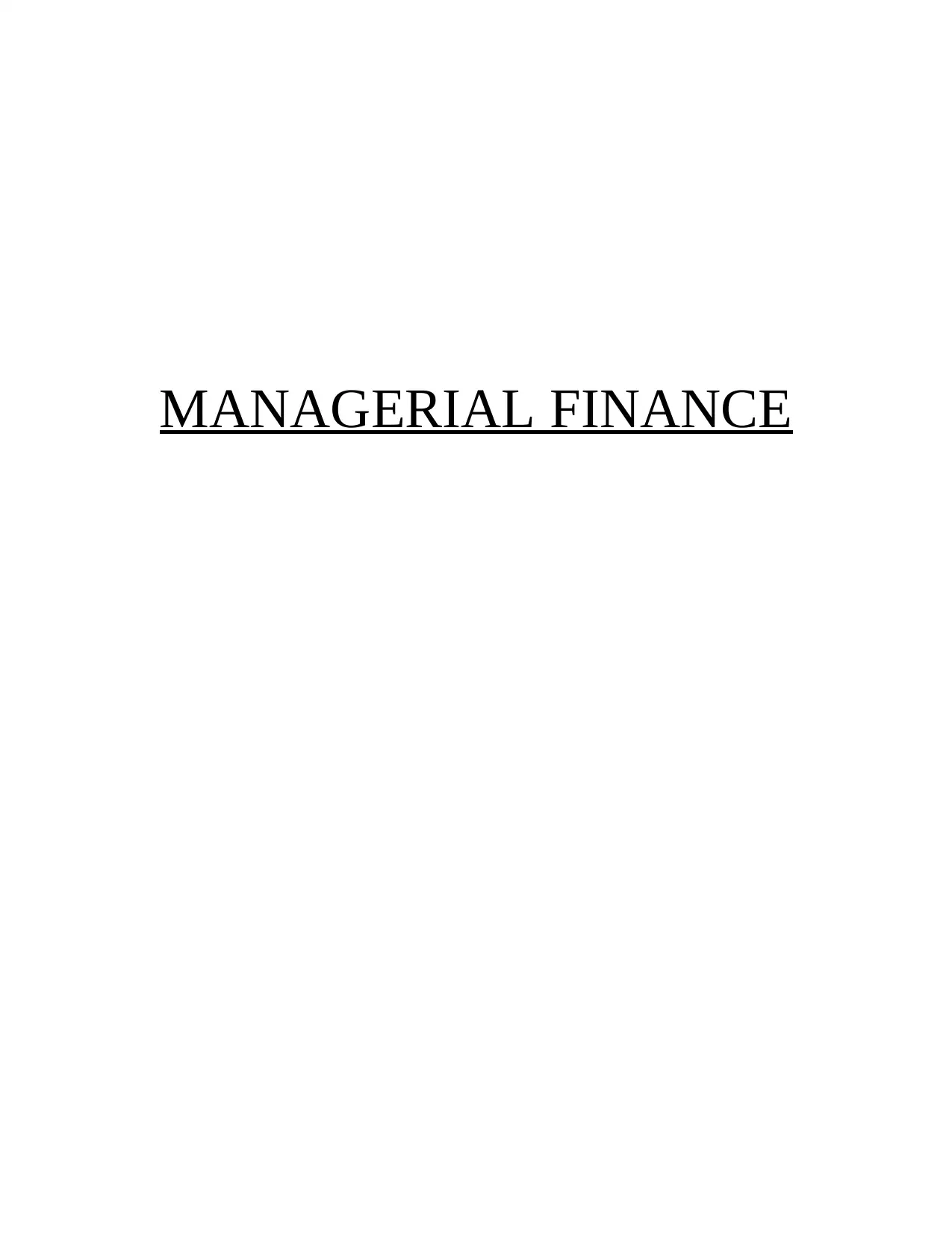
MANAGERIAL FINANCE
Paraphrase This Document
Need a fresh take? Get an instant paraphrase of this document with our AI Paraphraser
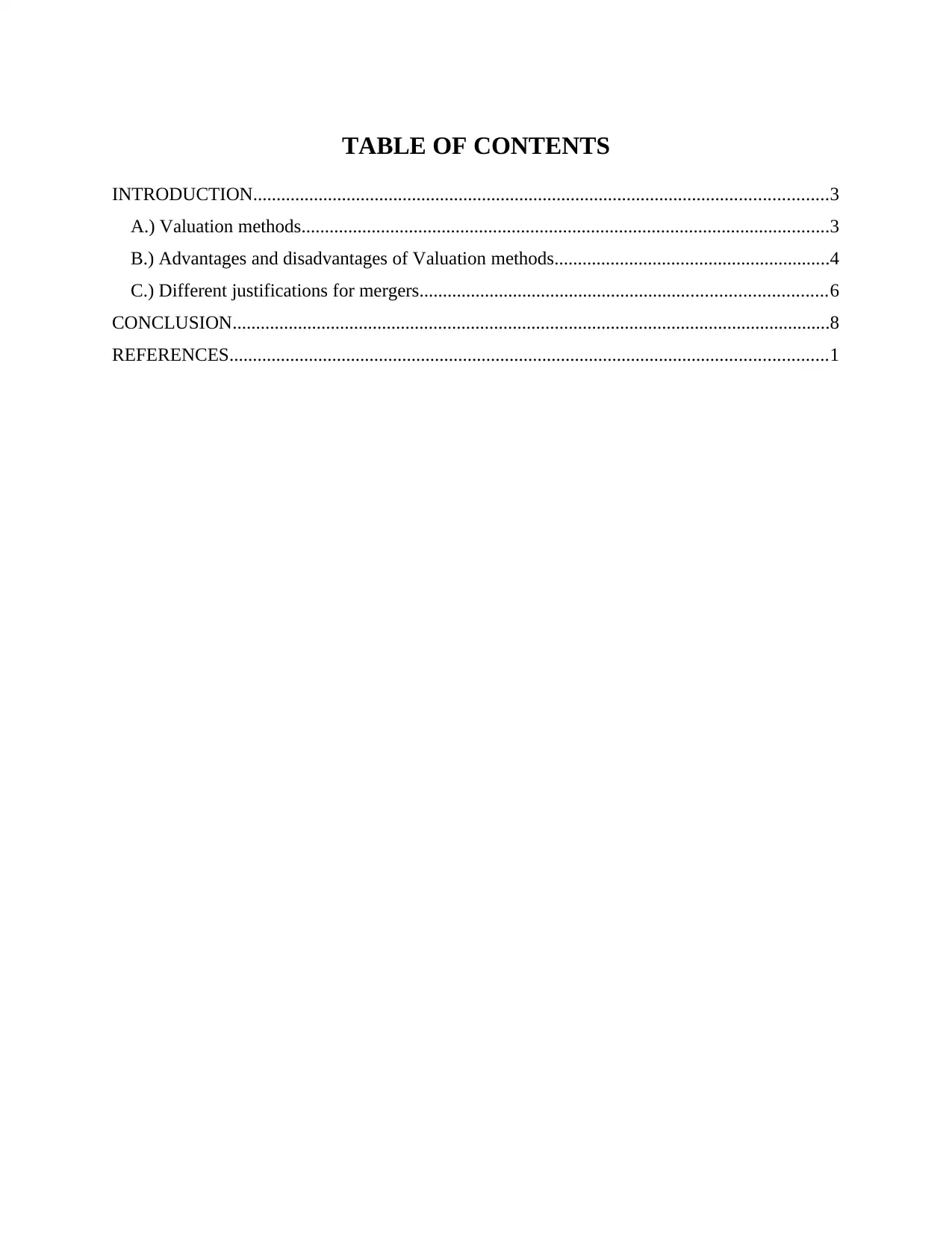
TABLE OF CONTENTS
INTRODUCTION...........................................................................................................................3
A.) Valuation methods.................................................................................................................3
B.) Advantages and disadvantages of Valuation methods...........................................................4
C.) Different justifications for mergers.......................................................................................6
CONCLUSION................................................................................................................................8
REFERENCES................................................................................................................................1
INTRODUCTION...........................................................................................................................3
A.) Valuation methods.................................................................................................................3
B.) Advantages and disadvantages of Valuation methods...........................................................4
C.) Different justifications for mergers.......................................................................................6
CONCLUSION................................................................................................................................8
REFERENCES................................................................................................................................1
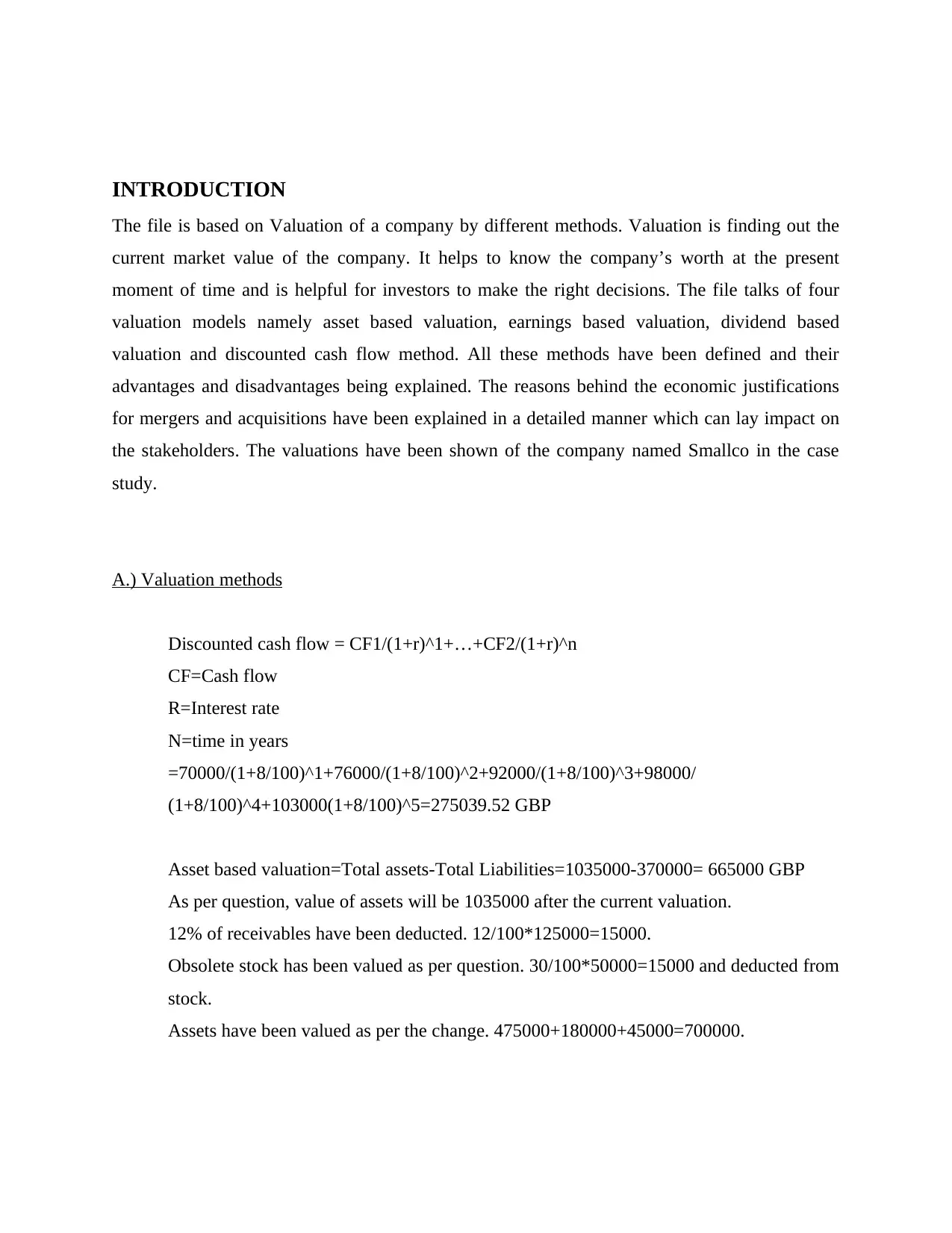
INTRODUCTION
The file is based on Valuation of a company by different methods. Valuation is finding out the
current market value of the company. It helps to know the company’s worth at the present
moment of time and is helpful for investors to make the right decisions. The file talks of four
valuation models namely asset based valuation, earnings based valuation, dividend based
valuation and discounted cash flow method. All these methods have been defined and their
advantages and disadvantages being explained. The reasons behind the economic justifications
for mergers and acquisitions have been explained in a detailed manner which can lay impact on
the stakeholders. The valuations have been shown of the company named Smallco in the case
study.
A.) Valuation methods
Discounted cash flow = CF1/(1+r)^1+…+CF2/(1+r)^n
CF=Cash flow
R=Interest rate
N=time in years
=70000/(1+8/100)^1+76000/(1+8/100)^2+92000/(1+8/100)^3+98000/
(1+8/100)^4+103000(1+8/100)^5=275039.52 GBP
Asset based valuation=Total assets-Total Liabilities=1035000-370000= 665000 GBP
As per question, value of assets will be 1035000 after the current valuation.
12% of receivables have been deducted. 12/100*125000=15000.
Obsolete stock has been valued as per question. 30/100*50000=15000 and deducted from
stock.
Assets have been valued as per the change. 475000+180000+45000=700000.
The file is based on Valuation of a company by different methods. Valuation is finding out the
current market value of the company. It helps to know the company’s worth at the present
moment of time and is helpful for investors to make the right decisions. The file talks of four
valuation models namely asset based valuation, earnings based valuation, dividend based
valuation and discounted cash flow method. All these methods have been defined and their
advantages and disadvantages being explained. The reasons behind the economic justifications
for mergers and acquisitions have been explained in a detailed manner which can lay impact on
the stakeholders. The valuations have been shown of the company named Smallco in the case
study.
A.) Valuation methods
Discounted cash flow = CF1/(1+r)^1+…+CF2/(1+r)^n
CF=Cash flow
R=Interest rate
N=time in years
=70000/(1+8/100)^1+76000/(1+8/100)^2+92000/(1+8/100)^3+98000/
(1+8/100)^4+103000(1+8/100)^5=275039.52 GBP
Asset based valuation=Total assets-Total Liabilities=1035000-370000= 665000 GBP
As per question, value of assets will be 1035000 after the current valuation.
12% of receivables have been deducted. 12/100*125000=15000.
Obsolete stock has been valued as per question. 30/100*50000=15000 and deducted from
stock.
Assets have been valued as per the change. 475000+180000+45000=700000.
⊘ This is a preview!⊘
Do you want full access?
Subscribe today to unlock all pages.

Trusted by 1+ million students worldwide
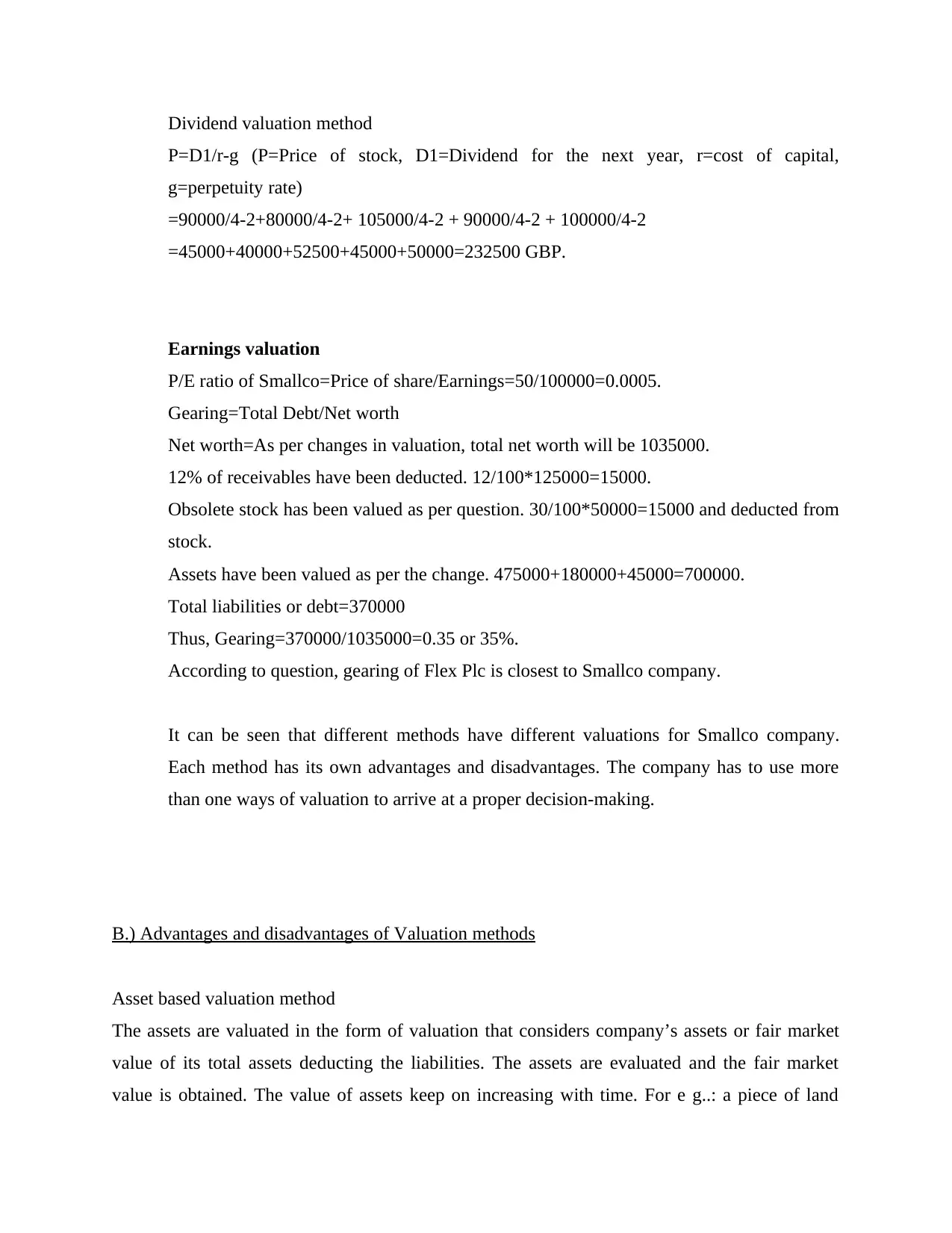
Dividend valuation method
P=D1/r-g (P=Price of stock, D1=Dividend for the next year, r=cost of capital,
g=perpetuity rate)
=90000/4-2+80000/4-2+ 105000/4-2 + 90000/4-2 + 100000/4-2
=45000+40000+52500+45000+50000=232500 GBP.
Earnings valuation
P/E ratio of Smallco=Price of share/Earnings=50/100000=0.0005.
Gearing=Total Debt/Net worth
Net worth=As per changes in valuation, total net worth will be 1035000.
12% of receivables have been deducted. 12/100*125000=15000.
Obsolete stock has been valued as per question. 30/100*50000=15000 and deducted from
stock.
Assets have been valued as per the change. 475000+180000+45000=700000.
Total liabilities or debt=370000
Thus, Gearing=370000/1035000=0.35 or 35%.
According to question, gearing of Flex Plc is closest to Smallco company.
It can be seen that different methods have different valuations for Smallco company.
Each method has its own advantages and disadvantages. The company has to use more
than one ways of valuation to arrive at a proper decision-making.
B.) Advantages and disadvantages of Valuation methods
Asset based valuation method
The assets are valuated in the form of valuation that considers company’s assets or fair market
value of its total assets deducting the liabilities. The assets are evaluated and the fair market
value is obtained. The value of assets keep on increasing with time. For e g..: a piece of land
P=D1/r-g (P=Price of stock, D1=Dividend for the next year, r=cost of capital,
g=perpetuity rate)
=90000/4-2+80000/4-2+ 105000/4-2 + 90000/4-2 + 100000/4-2
=45000+40000+52500+45000+50000=232500 GBP.
Earnings valuation
P/E ratio of Smallco=Price of share/Earnings=50/100000=0.0005.
Gearing=Total Debt/Net worth
Net worth=As per changes in valuation, total net worth will be 1035000.
12% of receivables have been deducted. 12/100*125000=15000.
Obsolete stock has been valued as per question. 30/100*50000=15000 and deducted from
stock.
Assets have been valued as per the change. 475000+180000+45000=700000.
Total liabilities or debt=370000
Thus, Gearing=370000/1035000=0.35 or 35%.
According to question, gearing of Flex Plc is closest to Smallco company.
It can be seen that different methods have different valuations for Smallco company.
Each method has its own advantages and disadvantages. The company has to use more
than one ways of valuation to arrive at a proper decision-making.
B.) Advantages and disadvantages of Valuation methods
Asset based valuation method
The assets are valuated in the form of valuation that considers company’s assets or fair market
value of its total assets deducting the liabilities. The assets are evaluated and the fair market
value is obtained. The value of assets keep on increasing with time. For e g..: a piece of land
Paraphrase This Document
Need a fresh take? Get an instant paraphrase of this document with our AI Paraphraser
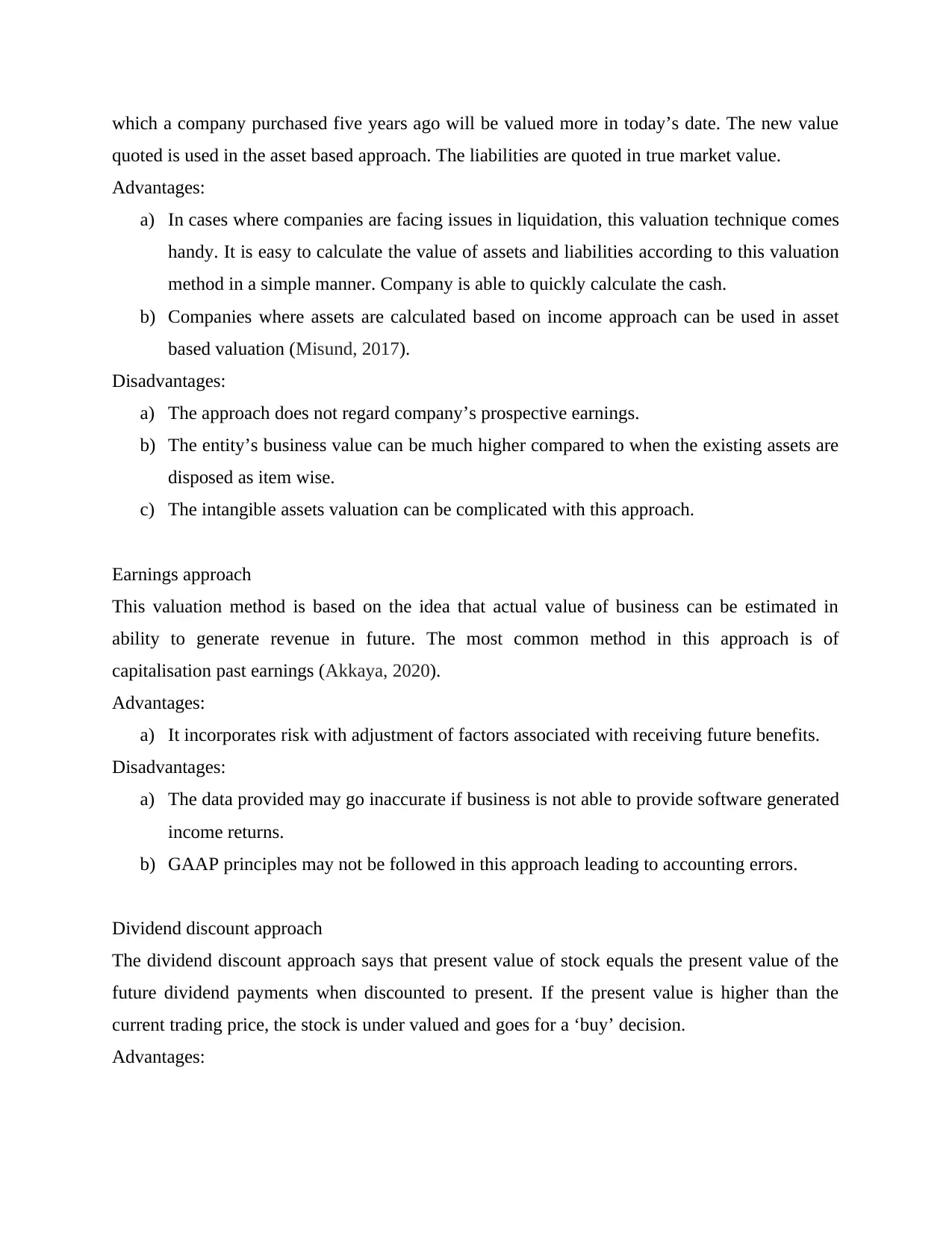
which a company purchased five years ago will be valued more in today’s date. The new value
quoted is used in the asset based approach. The liabilities are quoted in true market value.
Advantages:
a) In cases where companies are facing issues in liquidation, this valuation technique comes
handy. It is easy to calculate the value of assets and liabilities according to this valuation
method in a simple manner. Company is able to quickly calculate the cash.
b) Companies where assets are calculated based on income approach can be used in asset
based valuation (Misund, 2017).
Disadvantages:
a) The approach does not regard company’s prospective earnings.
b) The entity’s business value can be much higher compared to when the existing assets are
disposed as item wise.
c) The intangible assets valuation can be complicated with this approach.
Earnings approach
This valuation method is based on the idea that actual value of business can be estimated in
ability to generate revenue in future. The most common method in this approach is of
capitalisation past earnings (Akkaya, 2020).
Advantages:
a) It incorporates risk with adjustment of factors associated with receiving future benefits.
Disadvantages:
a) The data provided may go inaccurate if business is not able to provide software generated
income returns.
b) GAAP principles may not be followed in this approach leading to accounting errors.
Dividend discount approach
The dividend discount approach says that present value of stock equals the present value of the
future dividend payments when discounted to present. If the present value is higher than the
current trading price, the stock is under valued and goes for a ‘buy’ decision.
Advantages:
quoted is used in the asset based approach. The liabilities are quoted in true market value.
Advantages:
a) In cases where companies are facing issues in liquidation, this valuation technique comes
handy. It is easy to calculate the value of assets and liabilities according to this valuation
method in a simple manner. Company is able to quickly calculate the cash.
b) Companies where assets are calculated based on income approach can be used in asset
based valuation (Misund, 2017).
Disadvantages:
a) The approach does not regard company’s prospective earnings.
b) The entity’s business value can be much higher compared to when the existing assets are
disposed as item wise.
c) The intangible assets valuation can be complicated with this approach.
Earnings approach
This valuation method is based on the idea that actual value of business can be estimated in
ability to generate revenue in future. The most common method in this approach is of
capitalisation past earnings (Akkaya, 2020).
Advantages:
a) It incorporates risk with adjustment of factors associated with receiving future benefits.
Disadvantages:
a) The data provided may go inaccurate if business is not able to provide software generated
income returns.
b) GAAP principles may not be followed in this approach leading to accounting errors.
Dividend discount approach
The dividend discount approach says that present value of stock equals the present value of the
future dividend payments when discounted to present. If the present value is higher than the
current trading price, the stock is under valued and goes for a ‘buy’ decision.
Advantages:
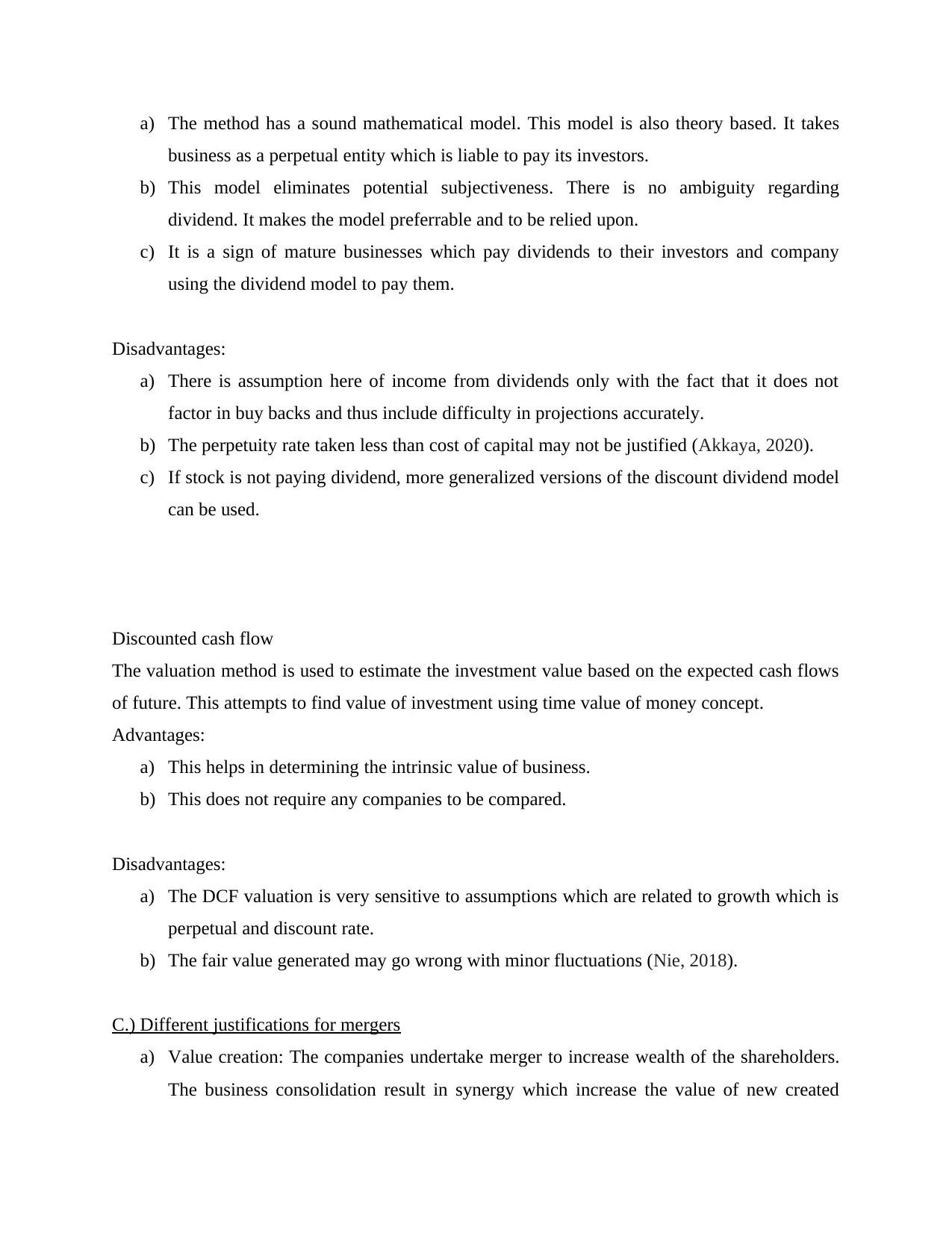
a) The method has a sound mathematical model. This model is also theory based. It takes
business as a perpetual entity which is liable to pay its investors.
b) This model eliminates potential subjectiveness. There is no ambiguity regarding
dividend. It makes the model preferrable and to be relied upon.
c) It is a sign of mature businesses which pay dividends to their investors and company
using the dividend model to pay them.
Disadvantages:
a) There is assumption here of income from dividends only with the fact that it does not
factor in buy backs and thus include difficulty in projections accurately.
b) The perpetuity rate taken less than cost of capital may not be justified (Akkaya, 2020).
c) If stock is not paying dividend, more generalized versions of the discount dividend model
can be used.
Discounted cash flow
The valuation method is used to estimate the investment value based on the expected cash flows
of future. This attempts to find value of investment using time value of money concept.
Advantages:
a) This helps in determining the intrinsic value of business.
b) This does not require any companies to be compared.
Disadvantages:
a) The DCF valuation is very sensitive to assumptions which are related to growth which is
perpetual and discount rate.
b) The fair value generated may go wrong with minor fluctuations (Nie, 2018).
C.) Different justifications for mergers
a) Value creation: The companies undertake merger to increase wealth of the shareholders.
The business consolidation result in synergy which increase the value of new created
business as a perpetual entity which is liable to pay its investors.
b) This model eliminates potential subjectiveness. There is no ambiguity regarding
dividend. It makes the model preferrable and to be relied upon.
c) It is a sign of mature businesses which pay dividends to their investors and company
using the dividend model to pay them.
Disadvantages:
a) There is assumption here of income from dividends only with the fact that it does not
factor in buy backs and thus include difficulty in projections accurately.
b) The perpetuity rate taken less than cost of capital may not be justified (Akkaya, 2020).
c) If stock is not paying dividend, more generalized versions of the discount dividend model
can be used.
Discounted cash flow
The valuation method is used to estimate the investment value based on the expected cash flows
of future. This attempts to find value of investment using time value of money concept.
Advantages:
a) This helps in determining the intrinsic value of business.
b) This does not require any companies to be compared.
Disadvantages:
a) The DCF valuation is very sensitive to assumptions which are related to growth which is
perpetual and discount rate.
b) The fair value generated may go wrong with minor fluctuations (Nie, 2018).
C.) Different justifications for mergers
a) Value creation: The companies undertake merger to increase wealth of the shareholders.
The business consolidation result in synergy which increase the value of new created
⊘ This is a preview!⊘
Do you want full access?
Subscribe today to unlock all pages.

Trusted by 1+ million students worldwide
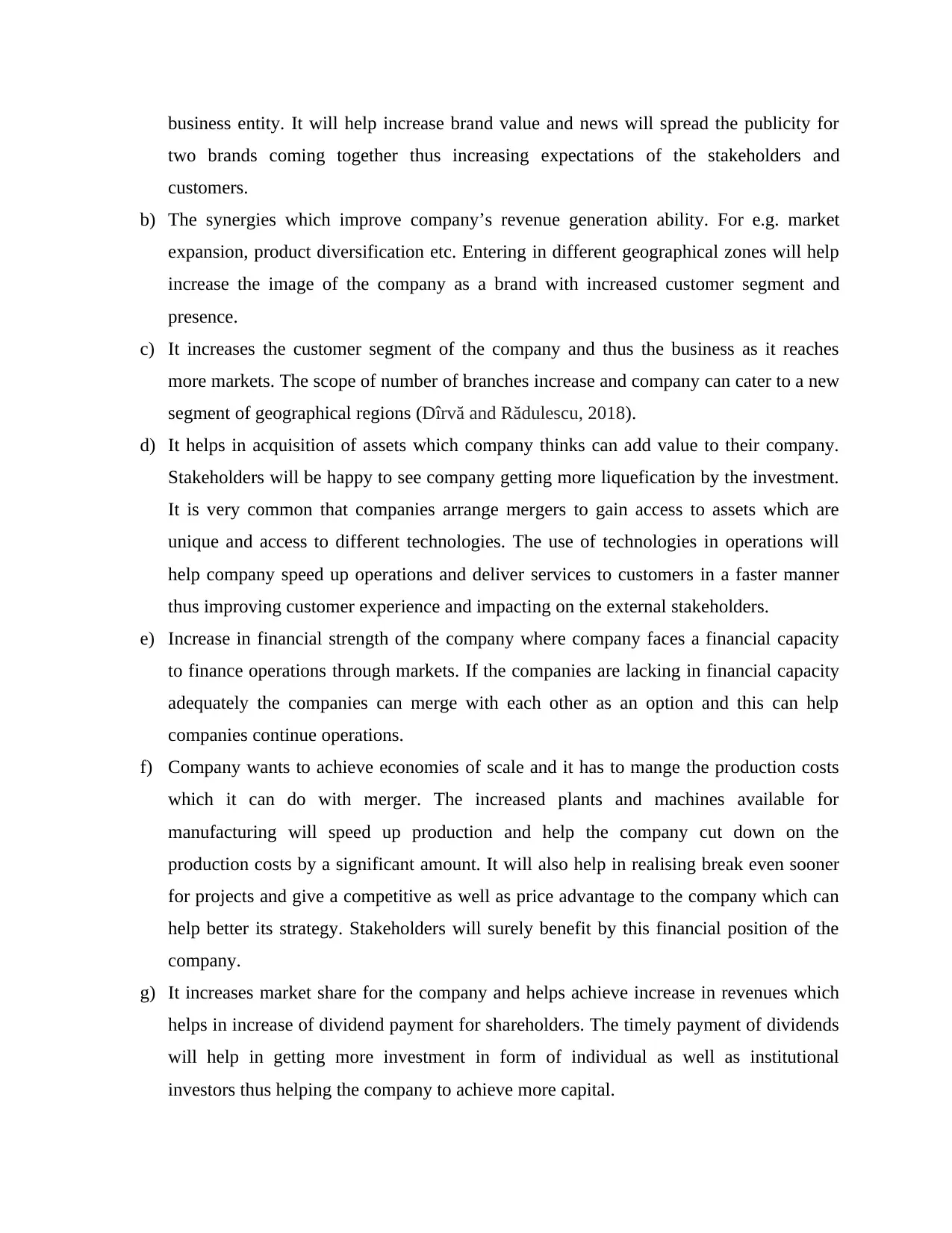
business entity. It will help increase brand value and news will spread the publicity for
two brands coming together thus increasing expectations of the stakeholders and
customers.
b) The synergies which improve company’s revenue generation ability. For e.g. market
expansion, product diversification etc. Entering in different geographical zones will help
increase the image of the company as a brand with increased customer segment and
presence.
c) It increases the customer segment of the company and thus the business as it reaches
more markets. The scope of number of branches increase and company can cater to a new
segment of geographical regions (Dîrvă and Rădulescu, 2018).
d) It helps in acquisition of assets which company thinks can add value to their company.
Stakeholders will be happy to see company getting more liquefication by the investment.
It is very common that companies arrange mergers to gain access to assets which are
unique and access to different technologies. The use of technologies in operations will
help company speed up operations and deliver services to customers in a faster manner
thus improving customer experience and impacting on the external stakeholders.
e) Increase in financial strength of the company where company faces a financial capacity
to finance operations through markets. If the companies are lacking in financial capacity
adequately the companies can merge with each other as an option and this can help
companies continue operations.
f) Company wants to achieve economies of scale and it has to mange the production costs
which it can do with merger. The increased plants and machines available for
manufacturing will speed up production and help the company cut down on the
production costs by a significant amount. It will also help in realising break even sooner
for projects and give a competitive as well as price advantage to the company which can
help better its strategy. Stakeholders will surely benefit by this financial position of the
company.
g) It increases market share for the company and helps achieve increase in revenues which
helps in increase of dividend payment for shareholders. The timely payment of dividends
will help in getting more investment in form of individual as well as institutional
investors thus helping the company to achieve more capital.
two brands coming together thus increasing expectations of the stakeholders and
customers.
b) The synergies which improve company’s revenue generation ability. For e.g. market
expansion, product diversification etc. Entering in different geographical zones will help
increase the image of the company as a brand with increased customer segment and
presence.
c) It increases the customer segment of the company and thus the business as it reaches
more markets. The scope of number of branches increase and company can cater to a new
segment of geographical regions (Dîrvă and Rădulescu, 2018).
d) It helps in acquisition of assets which company thinks can add value to their company.
Stakeholders will be happy to see company getting more liquefication by the investment.
It is very common that companies arrange mergers to gain access to assets which are
unique and access to different technologies. The use of technologies in operations will
help company speed up operations and deliver services to customers in a faster manner
thus improving customer experience and impacting on the external stakeholders.
e) Increase in financial strength of the company where company faces a financial capacity
to finance operations through markets. If the companies are lacking in financial capacity
adequately the companies can merge with each other as an option and this can help
companies continue operations.
f) Company wants to achieve economies of scale and it has to mange the production costs
which it can do with merger. The increased plants and machines available for
manufacturing will speed up production and help the company cut down on the
production costs by a significant amount. It will also help in realising break even sooner
for projects and give a competitive as well as price advantage to the company which can
help better its strategy. Stakeholders will surely benefit by this financial position of the
company.
g) It increases market share for the company and helps achieve increase in revenues which
helps in increase of dividend payment for shareholders. The timely payment of dividends
will help in getting more investment in form of individual as well as institutional
investors thus helping the company to achieve more capital.
Paraphrase This Document
Need a fresh take? Get an instant paraphrase of this document with our AI Paraphraser
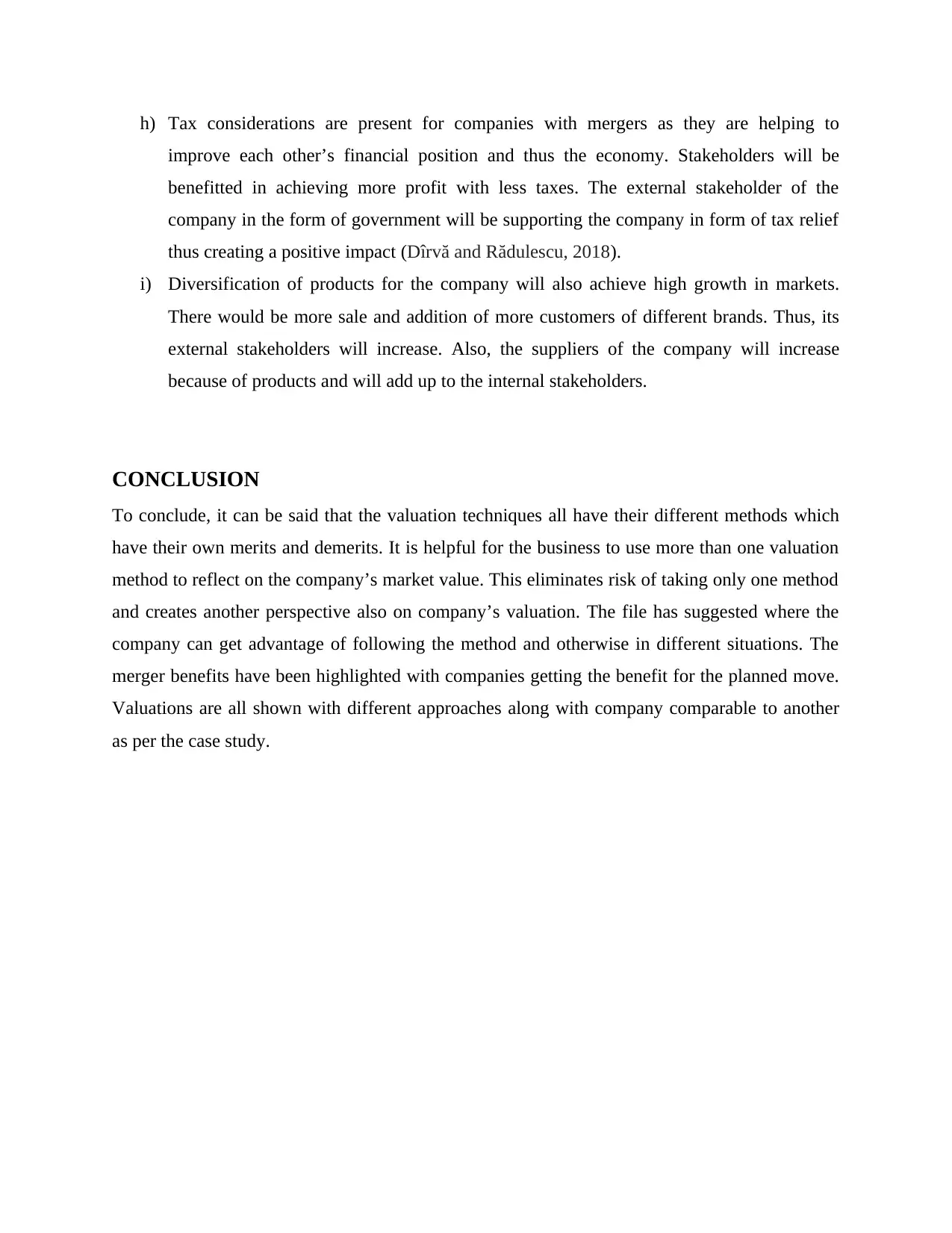
h) Tax considerations are present for companies with mergers as they are helping to
improve each other’s financial position and thus the economy. Stakeholders will be
benefitted in achieving more profit with less taxes. The external stakeholder of the
company in the form of government will be supporting the company in form of tax relief
thus creating a positive impact (Dîrvă and Rădulescu, 2018).
i) Diversification of products for the company will also achieve high growth in markets.
There would be more sale and addition of more customers of different brands. Thus, its
external stakeholders will increase. Also, the suppliers of the company will increase
because of products and will add up to the internal stakeholders.
CONCLUSION
To conclude, it can be said that the valuation techniques all have their different methods which
have their own merits and demerits. It is helpful for the business to use more than one valuation
method to reflect on the company’s market value. This eliminates risk of taking only one method
and creates another perspective also on company’s valuation. The file has suggested where the
company can get advantage of following the method and otherwise in different situations. The
merger benefits have been highlighted with companies getting the benefit for the planned move.
Valuations are all shown with different approaches along with company comparable to another
as per the case study.
improve each other’s financial position and thus the economy. Stakeholders will be
benefitted in achieving more profit with less taxes. The external stakeholder of the
company in the form of government will be supporting the company in form of tax relief
thus creating a positive impact (Dîrvă and Rădulescu, 2018).
i) Diversification of products for the company will also achieve high growth in markets.
There would be more sale and addition of more customers of different brands. Thus, its
external stakeholders will increase. Also, the suppliers of the company will increase
because of products and will add up to the internal stakeholders.
CONCLUSION
To conclude, it can be said that the valuation techniques all have their different methods which
have their own merits and demerits. It is helpful for the business to use more than one valuation
method to reflect on the company’s market value. This eliminates risk of taking only one method
and creates another perspective also on company’s valuation. The file has suggested where the
company can get advantage of following the method and otherwise in different situations. The
merger benefits have been highlighted with companies getting the benefit for the planned move.
Valuations are all shown with different approaches along with company comparable to another
as per the case study.
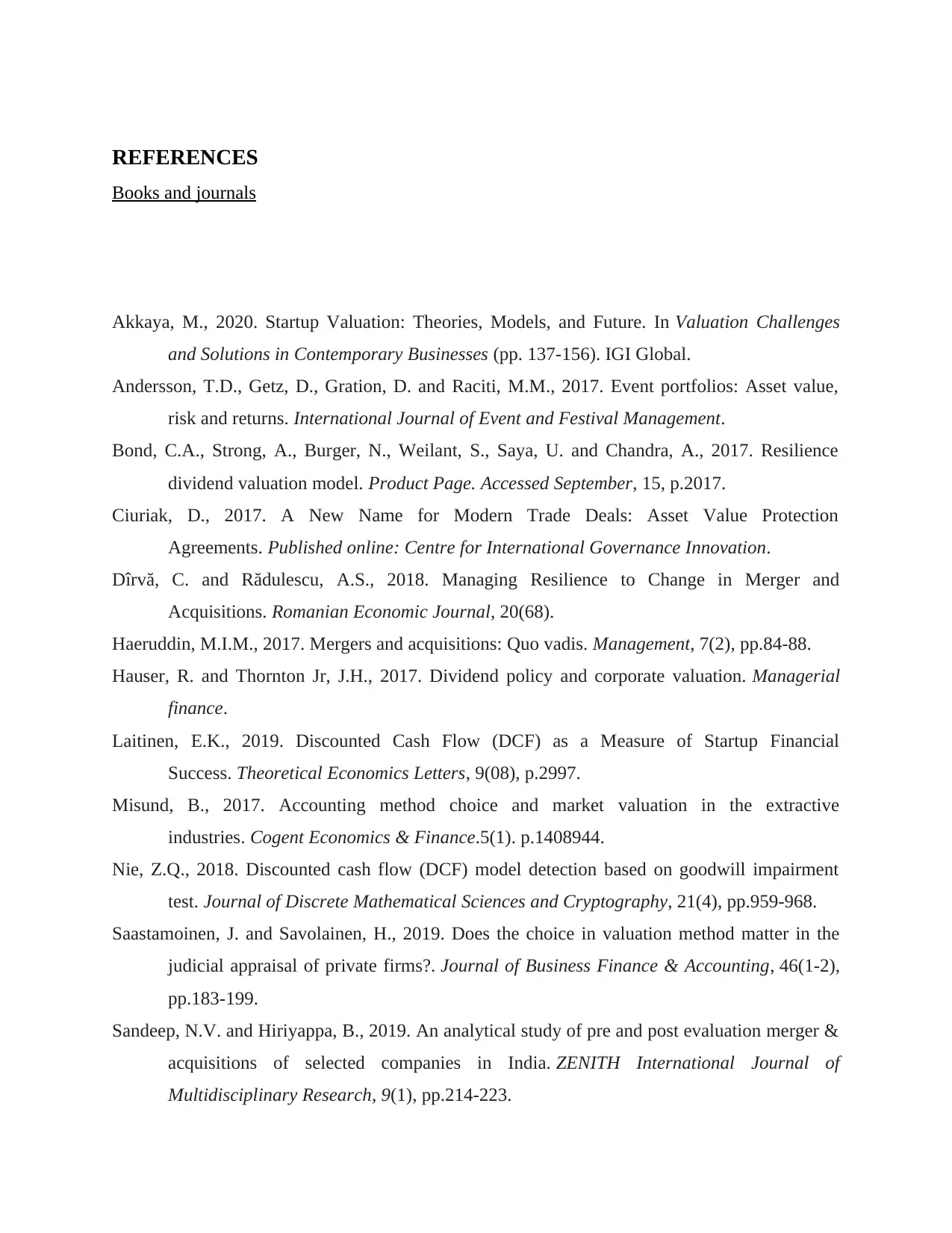
REFERENCES
Books and journals
Akkaya, M., 2020. Startup Valuation: Theories, Models, and Future. In Valuation Challenges
and Solutions in Contemporary Businesses (pp. 137-156). IGI Global.
Andersson, T.D., Getz, D., Gration, D. and Raciti, M.M., 2017. Event portfolios: Asset value,
risk and returns. International Journal of Event and Festival Management.
Bond, C.A., Strong, A., Burger, N., Weilant, S., Saya, U. and Chandra, A., 2017. Resilience
dividend valuation model. Product Page. Accessed September, 15, p.2017.
Ciuriak, D., 2017. A New Name for Modern Trade Deals: Asset Value Protection
Agreements. Published online: Centre for International Governance Innovation.
Dîrvă, C. and Rădulescu, A.S., 2018. Managing Resilience to Change in Merger and
Acquisitions. Romanian Economic Journal, 20(68).
Haeruddin, M.I.M., 2017. Mergers and acquisitions: Quo vadis. Management, 7(2), pp.84-88.
Hauser, R. and Thornton Jr, J.H., 2017. Dividend policy and corporate valuation. Managerial
finance.
Laitinen, E.K., 2019. Discounted Cash Flow (DCF) as a Measure of Startup Financial
Success. Theoretical Economics Letters, 9(08), p.2997.
Misund, B., 2017. Accounting method choice and market valuation in the extractive
industries. Cogent Economics & Finance.5(1). p.1408944.
Nie, Z.Q., 2018. Discounted cash flow (DCF) model detection based on goodwill impairment
test. Journal of Discrete Mathematical Sciences and Cryptography, 21(4), pp.959-968.
Saastamoinen, J. and Savolainen, H., 2019. Does the choice in valuation method matter in the
judicial appraisal of private firms?. Journal of Business Finance & Accounting, 46(1-2),
pp.183-199.
Sandeep, N.V. and Hiriyappa, B., 2019. An analytical study of pre and post evaluation merger &
acquisitions of selected companies in India. ZENITH International Journal of
Multidisciplinary Research, 9(1), pp.214-223.
Books and journals
Akkaya, M., 2020. Startup Valuation: Theories, Models, and Future. In Valuation Challenges
and Solutions in Contemporary Businesses (pp. 137-156). IGI Global.
Andersson, T.D., Getz, D., Gration, D. and Raciti, M.M., 2017. Event portfolios: Asset value,
risk and returns. International Journal of Event and Festival Management.
Bond, C.A., Strong, A., Burger, N., Weilant, S., Saya, U. and Chandra, A., 2017. Resilience
dividend valuation model. Product Page. Accessed September, 15, p.2017.
Ciuriak, D., 2017. A New Name for Modern Trade Deals: Asset Value Protection
Agreements. Published online: Centre for International Governance Innovation.
Dîrvă, C. and Rădulescu, A.S., 2018. Managing Resilience to Change in Merger and
Acquisitions. Romanian Economic Journal, 20(68).
Haeruddin, M.I.M., 2017. Mergers and acquisitions: Quo vadis. Management, 7(2), pp.84-88.
Hauser, R. and Thornton Jr, J.H., 2017. Dividend policy and corporate valuation. Managerial
finance.
Laitinen, E.K., 2019. Discounted Cash Flow (DCF) as a Measure of Startup Financial
Success. Theoretical Economics Letters, 9(08), p.2997.
Misund, B., 2017. Accounting method choice and market valuation in the extractive
industries. Cogent Economics & Finance.5(1). p.1408944.
Nie, Z.Q., 2018. Discounted cash flow (DCF) model detection based on goodwill impairment
test. Journal of Discrete Mathematical Sciences and Cryptography, 21(4), pp.959-968.
Saastamoinen, J. and Savolainen, H., 2019. Does the choice in valuation method matter in the
judicial appraisal of private firms?. Journal of Business Finance & Accounting, 46(1-2),
pp.183-199.
Sandeep, N.V. and Hiriyappa, B., 2019. An analytical study of pre and post evaluation merger &
acquisitions of selected companies in India. ZENITH International Journal of
Multidisciplinary Research, 9(1), pp.214-223.
⊘ This is a preview!⊘
Do you want full access?
Subscribe today to unlock all pages.

Trusted by 1+ million students worldwide
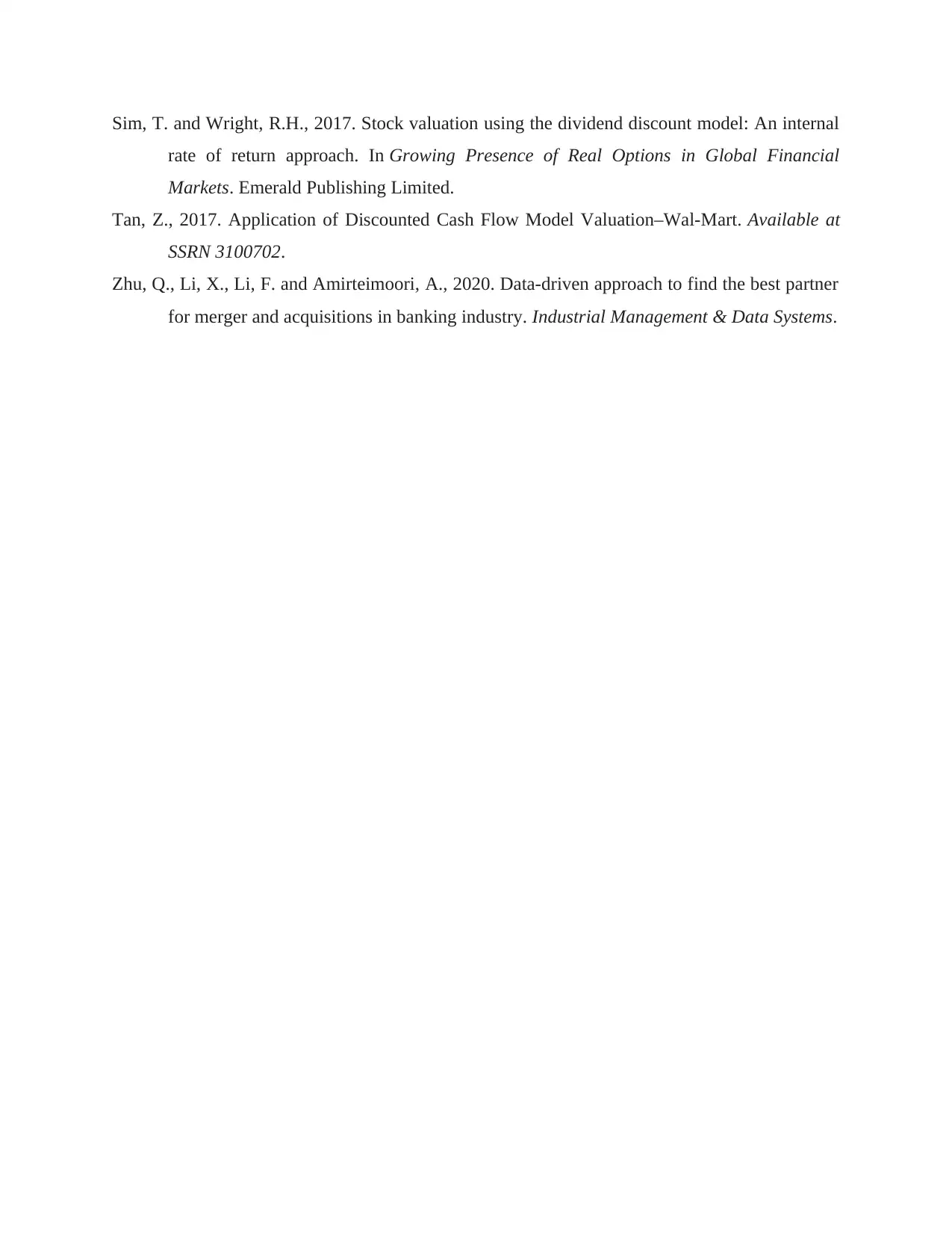
Sim, T. and Wright, R.H., 2017. Stock valuation using the dividend discount model: An internal
rate of return approach. In Growing Presence of Real Options in Global Financial
Markets. Emerald Publishing Limited.
Tan, Z., 2017. Application of Discounted Cash Flow Model Valuation–Wal-Mart. Available at
SSRN 3100702.
Zhu, Q., Li, X., Li, F. and Amirteimoori, A., 2020. Data-driven approach to find the best partner
for merger and acquisitions in banking industry. Industrial Management & Data Systems.
rate of return approach. In Growing Presence of Real Options in Global Financial
Markets. Emerald Publishing Limited.
Tan, Z., 2017. Application of Discounted Cash Flow Model Valuation–Wal-Mart. Available at
SSRN 3100702.
Zhu, Q., Li, X., Li, F. and Amirteimoori, A., 2020. Data-driven approach to find the best partner
for merger and acquisitions in banking industry. Industrial Management & Data Systems.
Paraphrase This Document
Need a fresh take? Get an instant paraphrase of this document with our AI Paraphraser

1
1 out of 11
Related Documents
Your All-in-One AI-Powered Toolkit for Academic Success.
+13062052269
info@desklib.com
Available 24*7 on WhatsApp / Email
![[object Object]](/_next/static/media/star-bottom.7253800d.svg)
Unlock your academic potential
Copyright © 2020–2025 A2Z Services. All Rights Reserved. Developed and managed by ZUCOL.





